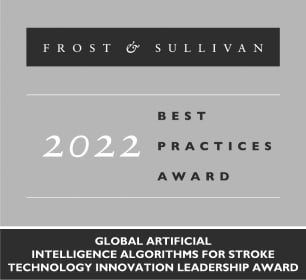At RapidAI, we understand that technology is just one part of any successful patient outcome. From the person who picks up the phone to call 9-1-1, to the first responders, doctors and other healthcare professionals providing care, there are many heroes in each story. Here, we spotlight these incredible individuals who are saving and changing lives in our Rapid Hero Stories.
Kevin Lixfield considers himself a lucky man. The 70-year-old resident of Medford, New York is a U.S. Marine Corps veteran who has survived several tours in Vietnam, not to mention cancer and a liver transplant. His most recent bout of luck occurred in April 2021 when he had a stroke.
Lixfield was at home watching television when his stroke occurred. He said he didn’t realize it was happening until his wife, Philippa, returned home and asked him a question. “Nothing came out but garble. My brain knew what I wanted to tell her, but the words didn’t come out,” he recalled.
Philippa asked him if he was having a stroke, and he gave her a thumbs up in response. She immediately called 9-1-1. Lixfield, who had no other deficit besides aphasia, felt strong enough to walk out to the ambulance when it arrived, and was immediately transported. He was taken to Stony Brook University Hospital, a comprehensive stroke center, roughly 20 minutes away.
As a matter of protocol, Lixfield received non-contrast CT and CT angiography scans, but neither scan alerted the stroke care team that anything was amiss. “The CTA looked totally normal. You would never suspect that there was anything wrong by looking at it,” said Dr. David Fiorella, the interventional neuroradiologist who treated Lixfield.
Lixfield was next given a CT perfusion scan. Luckily, Stony Brook is equipped with the Rapid advanced imaging platform. The analyzation and processing done by the software made it very easy for Fiorella to see that his patient was indeed having a stroke by identifying the areas of the brain affected by reduced blood flow. Dr. Fiorella could see that Lixfield was suffering from a distal vessel occlusion—a blockage in an artery so small that it couldn’t be seen on other types of brain scans.
In Lixfield’s case, the area of the brain affected by this blood clot was very small, but very impactful, because it was in the region that controlled speech. “He had a severe clinical deficit (aphasia) even though the artery that occluded was very small. It was an area of volume of only 12 CCs, but it was an extremely important 12 CCs,” Dr. Fiorella said.
Based on the Rapid CTP results, Dr. Fiorella was able to determine that his patient would benefit from endovascular intervention, something that would not have been possible to assess without the use of Rapid, he said. A mechanical thrombectomy was performed and successfully removed the clot, restoring blood flow to the crucial area of the brain responsible for Lixfield’s speech.
Typically, this type of procedure is not an option for patients with small, distal vessel strokes. “Usually, patients like him get IV tPA if they are within the window of treatment, but if they are outside the window, like he was, they are just given oxygen and an aspirin. Whatever deficit they have, they just have to try and recover from it through rehab,” Dr. Fiorella explained.
Lixfield’s recovery was also very surprising in terms of how swift it was. He was able to speak the next day and now has virtually no remaining deficit. This good fortune is not lost on him. As he puts it: “I lucked out, and I’m lucky enough to know when I luck out.”
RapidAI gives stroke teams and their patients more of what they desperately need: time. By notifying the entire stroke care team—doctors, emergency personnel and logistics—at the earliest possible moment and giving them the patient images and information they need to make the best possible decisions, they can save lives.
Rapid CTP results revealed the areas of Kevin Lixfield's brain that were impacted by his distal vessel occlusion. The areas in green indicate parts of the brain with reduced cerebral blood flow that could have been permanently damaged if blood flow was not restored.
"For distal occlusions, you're looking at very small vessels that are occluded,
and it's difficult to see those small vessels on a CTA, even when looking at the
source data. There are multiple, tortuous small vessels going up to the brain, and
to see one that's missing or one that comes up and stops is very, very difficult. I
think perfusion software is the best way to identify medium and distal vessel
occlusions in stroke, and Rapid CTP has provided the highest conspicuity for diagnosis of any tools that we have available.”
Dr. David Fiorella
Director, Stony Brook Cerebrovascular Center
Co-Director, Stony Brook Cerebrovascular and Comprehensive Stroke Center
At Stony Brook University Hospital, upwards of 200 mechanical thrombectomies are performed annually. But for each procedure, there are roughly five times as many stroke codes (potential stroke patients) that come through the hospital’s doors. “There are usually between three and ten a day,” said Dr. David Fiorella, director of the Stony Brook Cerebrovascular Center.
The high volume of CT scans associated with these stroke codes makes it difficult to single in on patients who potentially could benefit from interventional treatment. The Rapid imaging platform, though, has helped significantly with this, Dr. Fiorella said. Not only is he automatically notified when new scan results are available, but the color-coded CT perfusion maps created by the Rapid software allow for much easier interpretation by non-specialists. This means there are more helpful eyes from emergency department residents and mid-level providers who can alert him if he is unable to immediately view scan results, thus speeding up activation of the neuro-interventional team.
“Rapid makes complex data that is often difficult to interpret, and requires a lot of time, much more accessible to anyone along the care chain of the patient who only has a little familiarity with stroke,” Dr. Fiorella said. “It helps us to more quickly identify the patients in need of interventional services and differentiate them from stroke patients that would not benefit from intervention, or patients who aren't having a stroke at all.”


